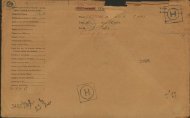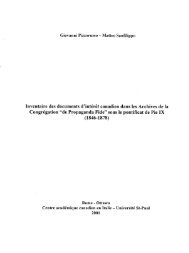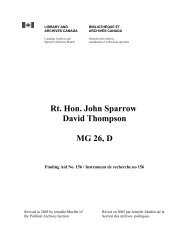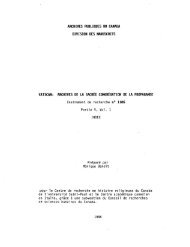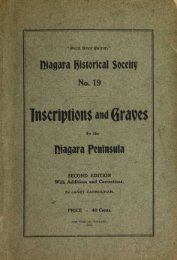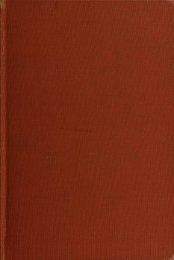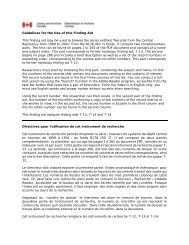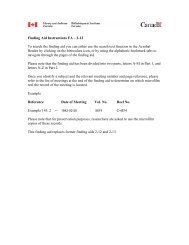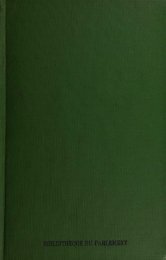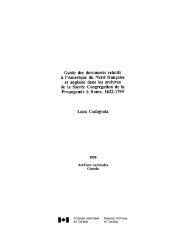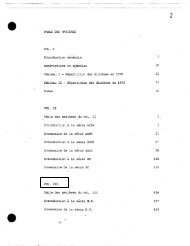Guide to Documents Relating to French and British North America in ...
Guide to Documents Relating to French and British North America in ...
Guide to Documents Relating to French and British North America in ...
You also want an ePaper? Increase the reach of your titles
YUMPU automatically turns print PDFs into web optimized ePapers that Google loves.
1971 <strong>and</strong> 1979 <strong>to</strong> honour the Congregation's 350th anniversary.soIt is a general his<strong>to</strong>ry of Propag<strong>and</strong>a,<br />
from its orig<strong>in</strong>s until <strong>to</strong>day, which consists of three volumes <strong>in</strong> five <strong>to</strong>mes conta<strong>in</strong><strong>in</strong>g articles written<br />
<strong>in</strong> various languages. These articles are organized along rough chronological l<strong>in</strong>es, but each deals with<br />
a special geographical area or general <strong>to</strong>pic. Six articles deal with <strong>North</strong> <strong>America</strong>, two of which are<br />
outside the chronological limits of the Calendar. sl In the appendix <strong>to</strong> vol. III/2, the list of the officials<br />
of the Congregation 52 is followed by a number of pr<strong>in</strong>ted documents from the archives of Propag<strong>and</strong>a.<br />
None of them is of special <strong>in</strong>terest <strong>to</strong> <strong>North</strong> <strong>America</strong>, but they all deal with general problems of the<br />
his<strong>to</strong>ry of missions that can be profitably consulted. 53<br />
The first <strong>North</strong> <strong>America</strong>n his<strong>to</strong>rian who used the archives of Propag<strong>and</strong>a was Etienne-Michel<br />
Faillon <strong>in</strong> his His<strong>to</strong>ire de la colonie franqaise. S4 He was particularly <strong>in</strong>terested <strong>in</strong> the his<strong>to</strong>ry of the<br />
erection of the bishopric of Quebec. Faillon gave special attention <strong>to</strong> vol. 256 of the SOCG series,<br />
whose title "<strong>America</strong> e Canada" made it an obvious choice. 55 As was common <strong>in</strong> his day, Faillon <strong>to</strong>ok<br />
<strong>to</strong>o many liberties with the documents he cited, <strong>and</strong> his critical apparatus was <strong>in</strong>consistent. S6 Faillon<br />
had personally consulted the archives of Propag<strong>and</strong>a when he was <strong>in</strong> Rome <strong>in</strong> 1864-1869 <strong>to</strong> establish<br />
the Sulpician procure. 57<br />
Another important his<strong>to</strong>rian of New France, the Jesuit Camille de Rochemonteix, used some<br />
documents of Propag<strong>and</strong>a relat<strong>in</strong>g <strong>to</strong> the early years of Bishop Fran~ois de Laval <strong>in</strong> Canada.58<br />
Rochemonteix, like Faillon, seems <strong>to</strong> know only vol. 256 of SOCG.<br />
The <strong>America</strong>n Catholic his<strong>to</strong>rian John Dawson Gilmary Shea S9 did not personally consult the<br />
archives of Propag<strong>and</strong>a, but had copies made through the archbishop of New York, Michael Corrigan. 60<br />
Shea's use of Propag<strong>and</strong>a documents is similar <strong>to</strong> that of Faillon <strong>and</strong> Rochemonteix -- <strong>to</strong>o many<br />
liberties with the documents, <strong>in</strong>consistency of the critical apparatus, <strong>and</strong> failure <strong>to</strong> properly cite orig<strong>in</strong>al<br />
documents. At any rate, Shea's use of the documents of Propag<strong>and</strong>a is limited.<br />
Although primarily concerned with the his<strong>to</strong>ry of the Society of Jesus, the four-volume work by<br />
the Jesuit Thomas Aloysius Hughes must be seen as a general his<strong>to</strong>ry of <strong>North</strong> <strong>America</strong>. Hughes's<br />
His<strong>to</strong>ry covers the whole cont<strong>in</strong>ent, <strong>in</strong>clud<strong>in</strong>g the West Indies but not Canada, <strong>in</strong> the seventeenth <strong>and</strong><br />
eighteenth centuries. 61 Hughes did not personally consult the archives of Propag<strong>and</strong>a, but, contrary <strong>to</strong><br />
Shea, he used Propag<strong>and</strong>a documents profusely. What he saw were copies preserved at George<strong>to</strong>wn<br />
University,62or copies that were made by his confrere Louis Schmitt. 63 Hughes did not cite or quote<br />
documents of Propag<strong>and</strong>a haphazardly -- they are often of central importance <strong>to</strong> his narrative.<br />
Unfortunately, he also <strong>to</strong>ok <strong>to</strong>o many liberties wIth the documents. The reader is at pa<strong>in</strong>s with the<br />
<strong>in</strong>consistency of his garbled critical apparatus, <strong>and</strong> confusion is the key-note of both the footnotes <strong>and</strong><br />
the two documentary volumes. Incidentally, he did not fmd much room for Propag<strong>and</strong>a <strong>in</strong> the two<br />
volumes of documents. His monumental His<strong>to</strong>ry is, however, contrary <strong>to</strong> Faillon, Rochemonteix <strong>and</strong><br />
Shea, still a useful start<strong>in</strong>g po<strong>in</strong>t for any researcher.<br />
If we turn from the category of works deal<strong>in</strong>g with the whole of the his<strong>to</strong>ry of <strong>North</strong> <strong>America</strong><br />
<strong>to</strong> survey the field of studies devoted <strong>to</strong> shorter periods, then we must first consider the work of the<br />
Franciscan Conrad Mor<strong>in</strong>. Mor<strong>in</strong> laboured for eight years <strong>in</strong> the Vatican Secret Archives <strong>and</strong> <strong>in</strong> other<br />
Roman archives, <strong>in</strong>clud<strong>in</strong>g Propag<strong>and</strong>a. He was a student at the Universita Gregoriana, where he <strong>to</strong>ok<br />
his doc<strong>to</strong>ral degree <strong>in</strong> ecclesiastical his<strong>to</strong>ry, writ<strong>in</strong>g a dissertation, discussed <strong>in</strong> July 1942, devoted <strong>to</strong><br />
the his<strong>to</strong>ry of the relationship between Canada <strong>and</strong> the Holy See. 64 He also published a short guide <strong>to</strong><br />
the Roman archives,65 discussed above, <strong>and</strong> an article on the efforts of the first Secretary of<br />
Propag<strong>and</strong>a, Francesco Ingoli, <strong>to</strong> erect a bishopric <strong>in</strong> Canada. 66 He wanted <strong>to</strong> do much more. His thesis<br />
was only the first portion of what was proposed as a three-part study, entitled "Le Sa<strong>in</strong>t-Siege et<br />
l'etablissement de l'Eglise au Canada sous Ie regime fran~ais," whose first volume, "L'affiliation au<br />
Sa<strong>in</strong>t-Siege ou la Mission apos<strong>to</strong>lique (1615-1658)," was <strong>to</strong> take him from the beg<strong>in</strong>n<strong>in</strong>gs <strong>to</strong> the<br />
establishment of a vicariate apos<strong>to</strong>lic <strong>in</strong> Canada. Although he often referred <strong>to</strong> his work as be<strong>in</strong>g at<br />
47



